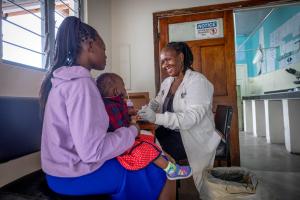Kenya: Strengthening the health workforce
Nairobi – Five years ago, Esther Omagwa was one of only two nurses at the Railways Health Centre in Kisumu County, western Kenya. The immense workload often exhausted her, forcing her to turn away clients.
Today, the scene at the community health centre is remarkably different. With the nursing staff now expanded to a team of four, Omagwa and her colleagues are better equipped to deal with the load.
“These days I can respond to patients efficiently. Even when one of us goes on leave, we still have capacity.” Esther Omagwa, nurse
The health centre’s overall staff has tripled to 30 and this includes specialists for services such as maternal and child health, cardiology, orthopaedics and mental health. “Since we have been able to incorporate more specialized services in each department, we haven’t had to refer as many patients to larger facilities,” says Violet Ouma, a laboratory officer at the health centre.
Kisumu is one of Kenya’s six model counties for human resources for health, having successfully piloted the primary health care networks initiative in Kenya and reflects a broader transformation that is taking place in the country’s health service delivery. According to Kenya’s 2023 Health Labour Market Analysis, the country has doubled its health workforce in the last 10 years to almost 190 000 active health workers across 13 major health occupations, including nurses, midwives, doctors, surgeons and other specialists. Currently, the country produces approximately 8200 health care workers annually and by 2031, the number of health workers is projected to climb to over 270 000.
Efforts to increase digitalization at facility level is producing timely and accurate data collection, which helps health authorities identify staffing needs and gaps, facilitate targeted training programmes and distribute medical professionals equitably across the country.
“In the past we’ve been using the manual way of collecting data and currently all our services are being digitalized,” says Flavia Naudi, Health Records Information Officer at Railways Health Centre. “We are part of the new generation that is actually using technology to improve healthcare service delivery on staffing and specialization.”
In 2019, World Health Organization (WHO) introduced Kenya’s Ministry of Health to the National Health Workforce Accounts, a system designed by the Organization to help countries collect, analyse and use data related to their health workforce. So far, the country has conducted three cycles, helping to better identify staffing needs and investment areas and aligning with the Kenya Human Resources for Health Strategy 2019–2023.
The implementation of National Health Workforce Accounts provided a foundation for a Health Labour Market Analysis, conducted between 2021 and 2023 and supported by WHO. The analysis provided evidence for the mismatch between supply and demand of health workers and the feasibility and impact of different policy options.
“Health workers are the backbone of the health system. The steps that the country is taking to improve the quality and quantity of the health workforce will help universal health coverage become a reality,” says Dr Abdourahmane Diallo, WHO Representative to Kenya.

Data shows that despite significant improvements, as of 2020, the density of health workers was 13.8 per 10 000 people, highlighting a significant gap in health care provision. For Kenya to meet population health needs and achieve universal health coverage by 2030, an estimated 7‒11% increase of current investment is required.
According to Professor Francis Wafula, the board chair of the Kenya Health Human Resource Advisory Council a critical issue is inequitable distribution of health care workers, not only across Kenya’s 47 counties but also between urban and rural areas, even in the six model counties. “We have a problem of poor distribution of health work force across the country. We need to strike a balance between what is acceptable in the context that we have and what inefficient use of the health workforce,” he says.
“Compared to the time when I was young, the nurses were few. But now, at least the numbers have improved.” Violet Odongo, health client
Despite these challenges, Kenya has several opportunities to further strengthen its health workforce. Recently President Williams Ruto inaugurated a presidential taskforce to lead human resources for health reforms in Kenya. This high-level commitment aims to attract more investments in health workforce to improve training, employment and retention. Additionally, the momentum from multi-stakeholder national dialogues, facilitated by WHO, offer a strategic advantage. The 2023 Kericho Declaration, emerging from one such dialogue, outlines a roadmap with clear action points for enhancing health workforce management and development.
For Violet Odongo, a client of Railways Health Centre, the improvements are making a difference. “The nurses and the doctors helped us so much and we are so relieved,” she says.
WHO Regional Office for Africa
Email: mroberts [at] who.int (mroberts[at]who[dot]int)
Communications and marketing officer
Tel: + 242 06 520 65 65 (WhatsApp)
Email: boakyeagyemangc [at] who.int (boakyeagyemangc[at]who[dot]int)



